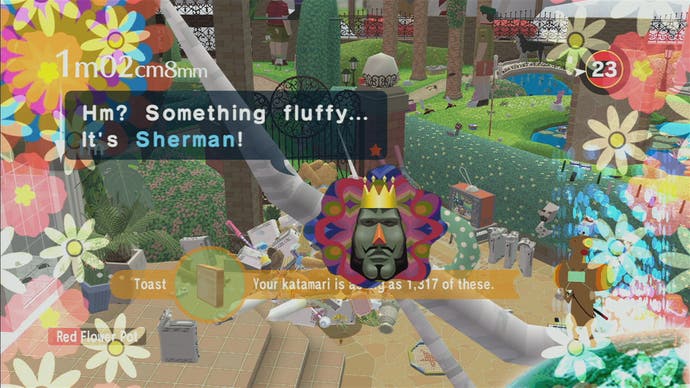Beautiful Katamari
Do not be fooled.
Katamari Damacy will very probably end up among the best PS2 games ever made. Either way, it is certainly among the best never released here. Its sequel - more of an intelligent remix - did appear, but in limited quantities quickly absorbed by fans. So, for an audience of Xbox 360 owners no doubt struggling to believe their luck at scooping Beautiful Katamari, why are these games so revered?
The answers are many. The simplicity of the original Katamari Damacy concept is the most obvious - so captivatingly gamey! Starting off with a pocket-size adhesive ball, your job is to push it around a room rolling over objects small enough to stick to its surface. As your ball - the titular katamari - gathers more and more objects, it grows in size and the scale of the world subtly adjusts so that things that previously deflected you become trivial enough to stick to the outer layer. The obvious potential - to start off on the carpet and come back later to roll over the house - is later realised, and the joy of watching things you've collected wiggle and squirm as they roll over the top of your creation is magic.
The first game's charm, however, was equally dependent on other elements. It was in the King of All Cosmos, a pompous caricature of infallible theocrats (with a delicious dash of regal syphilitic madness thrown in for good measure), who dispensed your goals; it was in the deliberately angular graphics, and the way objects burst with colour and sound when they joined the katamari; it was in the physicality of every object, and the way the ball's movement characteristics changed depending on the shape of the things stuck to the very outside.

The second game, We Love Katamari, inherited these things, and built upon them lovingly. Presented by a King apparently drunk on the cult success of "his" first game, it reshaped the concept to fit imaginative new circumstances, like rolling fireflies in the dark to light your way, and gently pillaging a garden for flowers as a delicate harmony wafted on the breeze. That We Love Katamari managed to reach similar heights to its predecessor was a testament to the developer's graceful composure as it walked a tightrope of expectation and - on the part of discerning observers - concern that something so measured could be extended at all.
The sheer delicacy of that composition - and the critical failure of Me & My Katamari on the PSP - probably ought to have dissuaded Namco Bandai from attempting anything else, but, perhaps swayed by the knowledge that critical and commercial responses on the first two games were inconsistent, it has returned for another go, albeit without series creator Keita Takahashi, and sadly without much deep understanding of why the first two Katamari games worked so well.
Beautiful Katamari borrows many of the ideas and themes detailed above, aiming to recapture the first two games' infectious sense of fun and humour - and reworking a number of catchy songs with impressive effect in the process - but unfortunately it misses out on one of their most significant, albeit relatively unsung achievements: both games' tremendous coherency, which ferried you unquestioningly along the first game's path of simple escalation, and then again along the second game's alternative journey.

Having punctured the cosmos with an errant tennis ball (whoops) and watched most of the stars and planets drain out of it, the King of All Cosmos stumbles onto the screen in the usual manner, but calamities of space and time appear to have made a fool of him; gone is the brash condescension, replaced with self-consciously comic dialogue that doesn't click the same way, which you quickly decide to skip past. It doesn't help that he seems to have lapsed into doddering senility, blurting the same things repeatedly.
This theme quickly extends to the gameplay. Once the King's out of the way, you begin by building a satellite, rolling over crayons, marbles, coins, mah-jong tiles, bells and dice, until you're of sufficient size to capture workbooks, toy knives, party whistles, mice and shuttlecocks. But soon after you're asked to begin again from around the same starting size, in the same place, but aim a bit bigger. Suddenly worried about a sense of repetition, the developer introduces secondary objectives, like building a ball out of hot objects, to a 10,000-centigrade temperature, carving a path across fried food and hot sauce platters but avoiding champagne.








